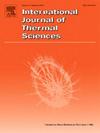Experimental study of heat transfer characteristics of bent high-temperature heat pipe
IF 4.9
2区 工程技术
Q1 ENGINEERING, MECHANICAL
International Journal of Thermal Sciences
Pub Date : 2025-06-17
DOI:10.1016/j.ijthermalsci.2025.110074
引用次数: 0
Abstract
The heat pipe, as a highly efficient heat transfer element, is well adapted to industrial applications with high heat flux. For compact system designs and compatibility with energy converters, bent high-temperature heat pipes are essential. However, the current research on the bending effect of heat pipes mainly focuses on the medium and low-temperature range, and there is a lack of systematic experiments on the heat transfer characteristics of bent high-temperature heat pipes. In this study, high-temperature sodium heat pipes were used as experimental objects, and the bend radius, wick structure type, bend position and bend number were set as variables to examine the changes in heat transfer characteristics of high-temperature heat pipes before and after bending by utilizing the axial temperature distribution, thermal resistance and heat transfer limit. High-temperature heat pipes exhibit performance degradation after bending, with increased thermal resistance and reduced heat transfer limits, significantly influenced by bend radius and wick structure. A bend radius of 250 mm raises temperatures by 40 °C and reduces the heat transfer limit by 10.48 %. Screen wick types show better resistance to bending with less than 10 % performance loss, while artery types deteriorate by 35.21 %. Bend position also affects performance; a lower bend position has better results. The performance of the heat pipe is not significantly degraded by the double bends and the bends near the evaporation section are the main cause of the degradation.
弯曲高温热管传热特性的实验研究
热管作为一种高效的传热元件,非常适合于高热流密度的工业应用。为了紧凑的系统设计和与能量转换器的兼容性,弯曲高温热管是必不可少的。然而,目前对热管弯曲效应的研究主要集中在中低温范围内,缺乏对弯曲高温热管传热特性的系统实验。本研究以高温钠热管为实验对象,以弯曲半径、芯芯结构类型、弯曲位置和弯曲次数为变量,利用轴向温度分布、热阻和传热极限考察高温热管弯曲前后传热特性的变化。高温热管弯曲后性能下降,热阻增加,传热极限降低,受弯曲半径和芯芯结构的显著影响。250mm的弯曲半径可使温度升高40°C,传热极限降低10.48%。筛网型灯芯的抗弯曲性能较好,性能损失小于10%,而动脉型灯芯的性能损失为35.21%。弯曲位置也影响性能;较低的弯曲姿势效果较好。双弯对热管性能的影响不明显,蒸发段附近的弯是造成热管性能下降的主要原因。
本文章由计算机程序翻译,如有差异,请以英文原文为准。
求助全文
约1分钟内获得全文
求助全文
来源期刊

International Journal of Thermal Sciences
工程技术-工程:机械
CiteScore
8.10
自引率
11.10%
发文量
531
审稿时长
55 days
期刊介绍:
The International Journal of Thermal Sciences is a journal devoted to the publication of fundamental studies on the physics of transfer processes in general, with an emphasis on thermal aspects and also applied research on various processes, energy systems and the environment. Articles are published in English and French, and are subject to peer review.
The fundamental subjects considered within the scope of the journal are:
* Heat and relevant mass transfer at all scales (nano, micro and macro) and in all types of material (heterogeneous, composites, biological,...) and fluid flow
* Forced, natural or mixed convection in reactive or non-reactive media
* Single or multi–phase fluid flow with or without phase change
* Near–and far–field radiative heat transfer
* Combined modes of heat transfer in complex systems (for example, plasmas, biological, geological,...)
* Multiscale modelling
The applied research topics include:
* Heat exchangers, heat pipes, cooling processes
* Transport phenomena taking place in industrial processes (chemical, food and agricultural, metallurgical, space and aeronautical, automobile industries)
* Nano–and micro–technology for energy, space, biosystems and devices
* Heat transport analysis in advanced systems
* Impact of energy–related processes on environment, and emerging energy systems
The study of thermophysical properties of materials and fluids, thermal measurement techniques, inverse methods, and the developments of experimental methods are within the scope of the International Journal of Thermal Sciences which also covers the modelling, and numerical methods applied to thermal transfer.
 求助内容:
求助内容: 应助结果提醒方式:
应助结果提醒方式:


